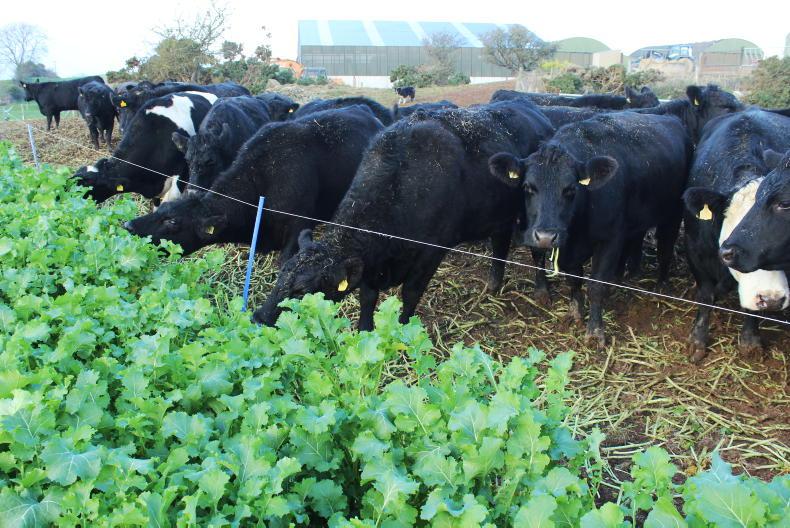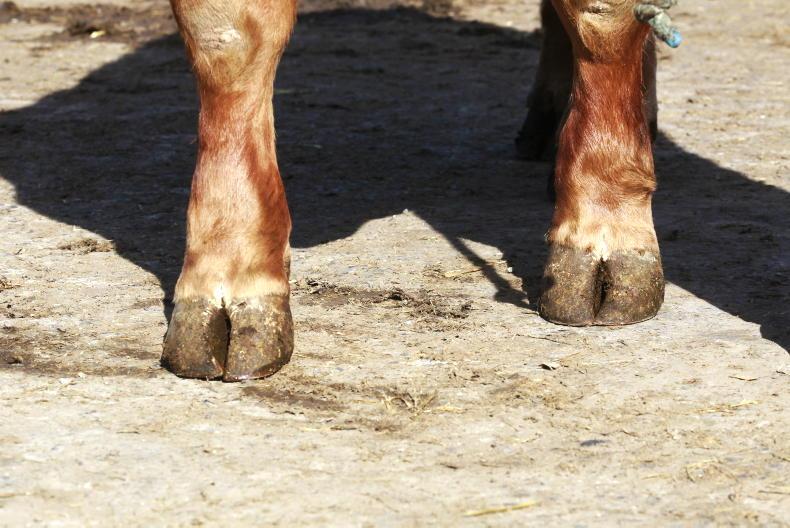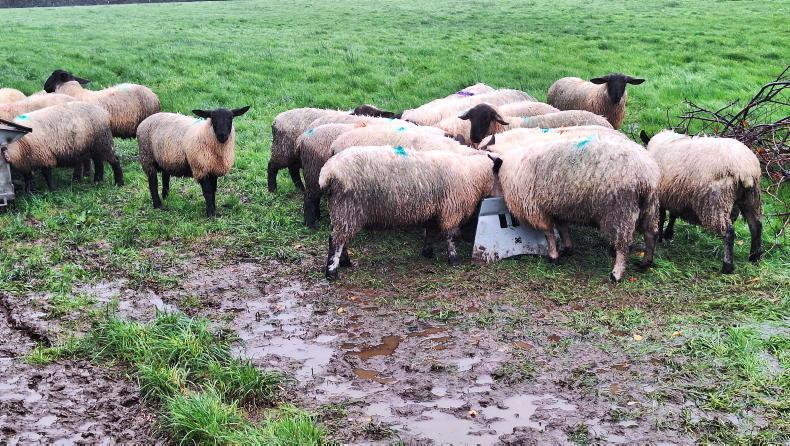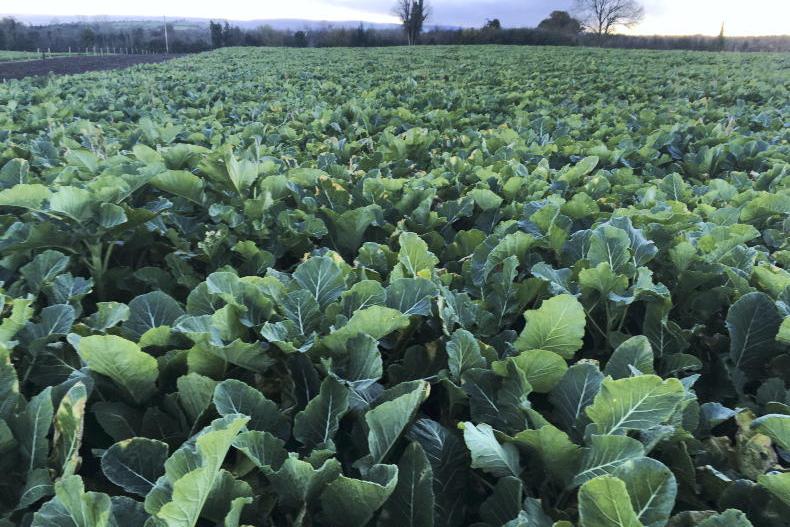Crops such as kale and forage rape offer many benefits from cutting down on slurry storage to having cows in fit condition when calving starts in spring.
Where farmers are considering planting such crops for the first time, there are a few things to keep in mind when grazing starts in late autumn, some of which are outlined as follows.
1: Choosing a field with shelter
When planting a fodder crop, farmers will automatically choose a dry field. However, the field should also have plenty of shelter.
In the depths of winter, cattle grazing in fields that are heavily exposed to wind and rain will be unsettled and more likely to break through wires.
2: Leave the headlands in grass for a lie-back
As well as good shelter provision, cattle should have access to a runback of some form to give a dry lying area.
Ideally, leave the headlands of the field in grass or stubbles as a lie-back. Alternatively, is there an adjacent paddock that is marked for reseeding that can be used as a lie-back?
3: Place the bales in the field
before autumn
Forage crops are low in fibre. Therefore, supplement animals with silage or straw on a daily basis to maintain healthy rumen function.
But rather than driving in and out of the field during the grazing period, bales should be placed in the field before autumn.
Place the bales in one or two lines from one end of the field to the other.
Once grazing starts, it is only a matter of rolling the ring feeder from one bale to the next.
4: Set up the wire to give the
widest feed face
Forage crops should be strip-grazed daily. Set up an electric wire to give the widest feed face possible.
All animals should be able to graze to appetite at the same time.
With a narrow feed face and a high stocking density, dominant cattle will eat their fill.
Shy animals will not get their allocation.
Also, with the wider feed face, there is less chance of cattle running out of fodder before the fence is due to be moved again.
5: Move the wire on time
It will take a couple of days to gauge how much of the crop to give animals in each allocation.
A lot will depend on the yield of the crop and number of animals grazing.
Flowering plants are toxic and cattle are more prone to problems such as red water, goitres and a sudden loss of appetite
Kale is higher-yielding than forage rape. It also grows much taller and the plant stalks are thicker which can lower utilisation.
Some farmers prefer to move the wire up to the edge of the kale crop, then let cattle graze below the wire. This gives more control over grazing and improves cleanout.
There is also less chance of the fence being earthed, which is an issue when placing the wire in the actual crop.
Forage rape is a lighter crop and grows less tall. As such, utilisation tends to be high and the wire can be moved in to the crop with less risk of earthing.
Where possible, use mains electricity to control the wire along the feed face.
Battery fencers can be used, but need a higher voltage to provide an adequate charge to control cattle.

Forage crops should be strip-grazed with fencers moved daily.
6: Which cattle to graze and
stocking rates?
Weanlings, stores and dry cows are best suited to grazing forage crops. Assuming cattle are eating 50% to 70% of dry matter intake as forage crops, a group of 20 stores weighing 400kg in November will eat 8kg of dry matter daily, or 160kg DM/day across the group.
For a crop of kale yielding 8t DM/ha, at 70% dry matter intake, 1ha of kale should last the group 50 days.
This is based on 70% utilisation and favourable grazing conditions.
For a group of 20 dry cows averaging 700kg, the same 1ha field will last around 30 days.
7: Transition cattle on to forage crops
Cattle should be gradually transitioned on to a forage crop over the course of one week. This gives the rumen time to adjust.
This is why leaving the headlands in grass comes in handy.
Cattle can graze headlands and be gradually phased on to the forage crop.
Buffer feed with silage, if necessary, during this period.
8: Fluke and minerals
Cattle on forage crops will be exposed to parasites such as liver fluke, so keep a close eye on animals for signs of a burden. A second fluke drench may well be needed in midwinter.
Forage crops are also low in minerals. Therefore, cattle need proper supplementation with trace elements.
9: Avoid grazing after heavy frost
On mornings with heavy frost, do not move the strip wire to give cattle their next allocation.
Frost increases nitrate levels in the plant, which can potentially poison animals.
Wait until the frost has thawed before moving the wire. Offer cattle an extra bale of silage until such time as the wire fence can be moved, helping to keep animals settled.
10: Do not graze once the crop flowers
Once forage crops start to flower in early spring, stop grazing and remove cattle from the field.
Flowering plants are toxic and cattle are more prone to problems such as redwater, goitres and a sudden loss of appetite.
Read more
Newford Farm: 10 week breeding season draws to a close
Thrive weekly roundup: focusing on forage in Kildare and demo farm update
Crops such as kale and forage rape offer many benefits from cutting down on slurry storage to having cows in fit condition when calving starts in spring.
Where farmers are considering planting such crops for the first time, there are a few things to keep in mind when grazing starts in late autumn, some of which are outlined as follows.
1: Choosing a field with shelter
When planting a fodder crop, farmers will automatically choose a dry field. However, the field should also have plenty of shelter.
In the depths of winter, cattle grazing in fields that are heavily exposed to wind and rain will be unsettled and more likely to break through wires.
2: Leave the headlands in grass for a lie-back
As well as good shelter provision, cattle should have access to a runback of some form to give a dry lying area.
Ideally, leave the headlands of the field in grass or stubbles as a lie-back. Alternatively, is there an adjacent paddock that is marked for reseeding that can be used as a lie-back?
3: Place the bales in the field
before autumn
Forage crops are low in fibre. Therefore, supplement animals with silage or straw on a daily basis to maintain healthy rumen function.
But rather than driving in and out of the field during the grazing period, bales should be placed in the field before autumn.
Place the bales in one or two lines from one end of the field to the other.
Once grazing starts, it is only a matter of rolling the ring feeder from one bale to the next.
4: Set up the wire to give the
widest feed face
Forage crops should be strip-grazed daily. Set up an electric wire to give the widest feed face possible.
All animals should be able to graze to appetite at the same time.
With a narrow feed face and a high stocking density, dominant cattle will eat their fill.
Shy animals will not get their allocation.
Also, with the wider feed face, there is less chance of cattle running out of fodder before the fence is due to be moved again.
5: Move the wire on time
It will take a couple of days to gauge how much of the crop to give animals in each allocation.
A lot will depend on the yield of the crop and number of animals grazing.
Flowering plants are toxic and cattle are more prone to problems such as red water, goitres and a sudden loss of appetite
Kale is higher-yielding than forage rape. It also grows much taller and the plant stalks are thicker which can lower utilisation.
Some farmers prefer to move the wire up to the edge of the kale crop, then let cattle graze below the wire. This gives more control over grazing and improves cleanout.
There is also less chance of the fence being earthed, which is an issue when placing the wire in the actual crop.
Forage rape is a lighter crop and grows less tall. As such, utilisation tends to be high and the wire can be moved in to the crop with less risk of earthing.
Where possible, use mains electricity to control the wire along the feed face.
Battery fencers can be used, but need a higher voltage to provide an adequate charge to control cattle.

Forage crops should be strip-grazed with fencers moved daily.
6: Which cattle to graze and
stocking rates?
Weanlings, stores and dry cows are best suited to grazing forage crops. Assuming cattle are eating 50% to 70% of dry matter intake as forage crops, a group of 20 stores weighing 400kg in November will eat 8kg of dry matter daily, or 160kg DM/day across the group.
For a crop of kale yielding 8t DM/ha, at 70% dry matter intake, 1ha of kale should last the group 50 days.
This is based on 70% utilisation and favourable grazing conditions.
For a group of 20 dry cows averaging 700kg, the same 1ha field will last around 30 days.
7: Transition cattle on to forage crops
Cattle should be gradually transitioned on to a forage crop over the course of one week. This gives the rumen time to adjust.
This is why leaving the headlands in grass comes in handy.
Cattle can graze headlands and be gradually phased on to the forage crop.
Buffer feed with silage, if necessary, during this period.
8: Fluke and minerals
Cattle on forage crops will be exposed to parasites such as liver fluke, so keep a close eye on animals for signs of a burden. A second fluke drench may well be needed in midwinter.
Forage crops are also low in minerals. Therefore, cattle need proper supplementation with trace elements.
9: Avoid grazing after heavy frost
On mornings with heavy frost, do not move the strip wire to give cattle their next allocation.
Frost increases nitrate levels in the plant, which can potentially poison animals.
Wait until the frost has thawed before moving the wire. Offer cattle an extra bale of silage until such time as the wire fence can be moved, helping to keep animals settled.
10: Do not graze once the crop flowers
Once forage crops start to flower in early spring, stop grazing and remove cattle from the field.
Flowering plants are toxic and cattle are more prone to problems such as redwater, goitres and a sudden loss of appetite.
Read more
Newford Farm: 10 week breeding season draws to a close
Thrive weekly roundup: focusing on forage in Kildare and demo farm update










SHARING OPTIONS